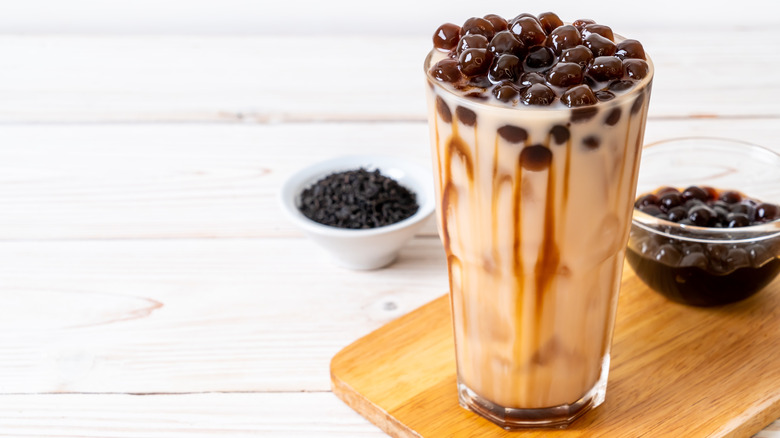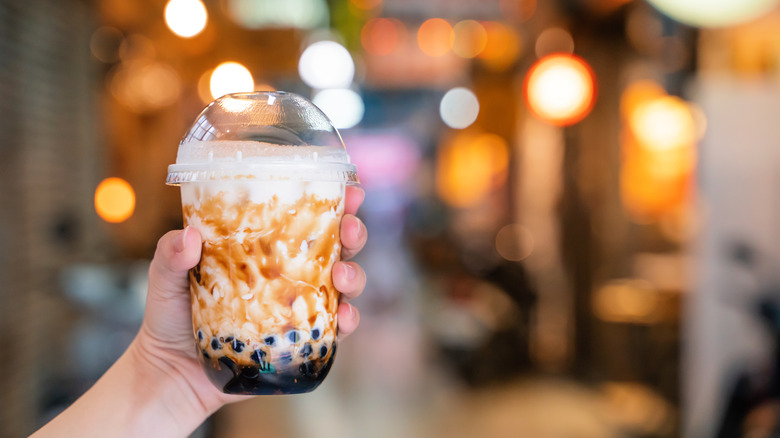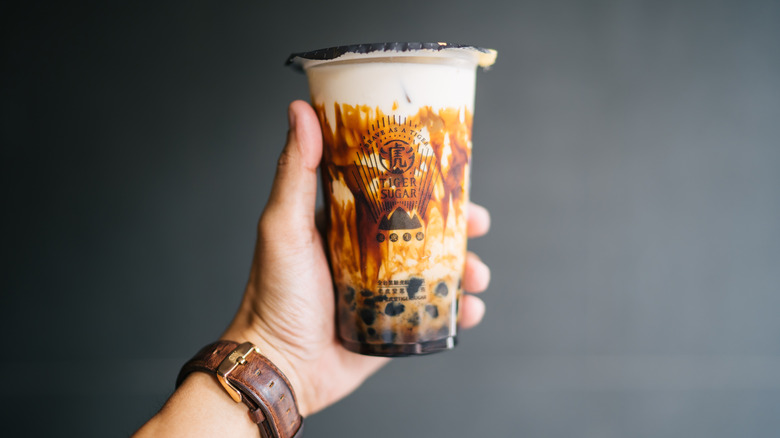How Tiger Bubble Tea Got Its Name
There are a few claims to the origination of bubble tea. According to Taipei Times, the bubble tea most of us enjoy today may have been invented in Taiwan in the 1980s. During that time, there was already a drink referred to as bubble tea, which was similar to today's version minus the trademark tapioca balls. It was made from green or black tea with sugar syrup and was shaken with ice until frothy.
Hanlin Tea Room in Tainan, Taiwan claims its founder Tu Tsung-ho was the first to add chewy tapioca balls to bubble tea in 1986. However, rival tea house Chun Shui Tang in Taichung, Taiwan claims it was the true creator. The two rival tea companies sued each other in hopes of being named the original inventor of bubble tea, but neither company had a trademark or patent, so the courts weren't able to prove anything. Meanwhile, some believe that bubble tea was inspired by an iced drink known as chendol or cendol from British Malaya, which is Malaysia and Singapore today. Cendol consists of sweetened coconut milk served over ice with chewy pieces made of sago or rice flour.
Regardless of its origins, bubble tea is now growing in popularity, with a valuation of about $2.4 billion in 2019 and a projected value of around $4.3 billion by 2027, per Allied Market Research. The growing market has produced many unique bubble tea flavors, such as tiger bubble tea — which holds an interesting reason behind its name.
Tiger bubble tea is named for the striped caramel pattern on the cups
There are almost infinite flavor options when it comes to bubble tea. First, the base can be milk and tea, just milk or just tea, fruit or fruit juice, and more, per Honest Food Talks. Then there are the toppings, which include the iconic tapioca pearls in various flavors, popping boba, fresh fruit, jelly, egg pudding, red beans, and much more. One of the most popular bubble tea flavors is brown sugar, and the picture-perfect drink made with this flavor has become known as tiger bubble tea. Made with brown sugar, milk, caramel, and tapioca pearls, tiger bubble tea is named for the design visible on the outside of the cup from the syrupy drizzle on its interior, which resembles the stripes of a tiger.
Tiger milk tea was made popular mostly by bubble tea shop Tiger Sugar, which opened in Taichung in 2017, per Michelin. Ironically, it doesn't contain any actual tea, and its tapioca balls are cooked in a brown sugar syrup to give it that signature, rich toffee-like flavor. The caramelly brown sugar "tiger" stripes quickly dissolve into the milk, staying on the inside of the cup just long enough for sippers to admire the design and maybe snap a picture.
How Tiger Sugar popularized tiger bubble tea
Opened in 2017, Tiger Sugar is the self-proclaimed creator of tiger bubble tea. The tea shop is so popular that people have been known to wait in line for as long as three hours just to experience its iconic brown sugar drink, which is meant to conjure up the flavors of traditional desserts from Taiwan, per Michelin. But to actually achieve the coveted treat, the wait is even longer: The popular bubble tea shop has a cooking method for its syrup-soaked tapioca pearls that takes about 8 hours, according to Tiger Sugar. And while some tea shops use creamer for their bubble teas, Tiger Sugar uses fresh milk that, as they describe it, adds a savory taste to complement the smokiness of the brown sugar syrup and boba.
The chain acknowledges that as word spread, its signature drink garnered many imitators due to its trendy design — you may have tried one yourself. But the tea shop maintains that its own brown sugar bubble tea is "an unforgettable taste of Taiwan." In fact, it took about 10 years to perfect the menu, which almost exclusively focuses on brown sugar bubble tea (or as shop calls it, "Tiger Black Sugar"). Due to its rising popularity and demand, Tiger Sugar has opened more stores in Taiwan, Singapore, and Hong Kong, per Michelin, and has several stores in 22 U.S. states where customers can enjoy the drink's unique taste and the "aesthetic feeling" that gave tiger bubble tea its name.


